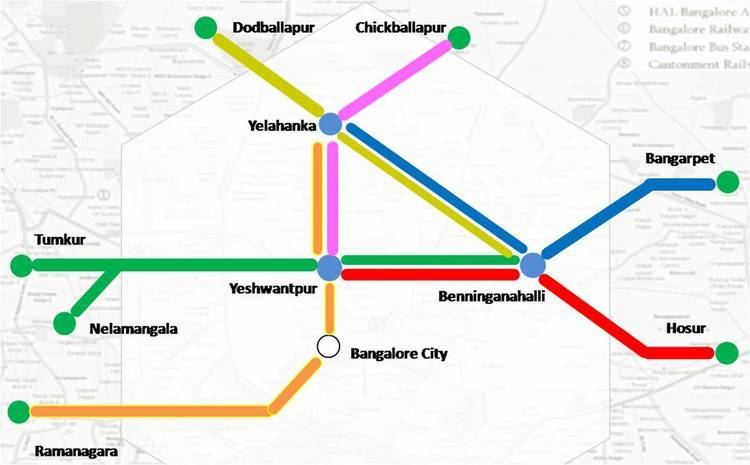System length 200,000 m Number of lines 4 | Locale Bengaluru Transit type Commuter rail | |
 | ||
Operator Bangalore Suburban Rail Company Limited | ||
Bangalore Commuter Rail (Kannada: ಬೆಂಗಳೂರು ಪ್ರಯಾಣಿಕರ ರೈಲು) is approved in 2014/2015 Railway Budget for suburban railway service for the city of Bangalore. So far no progress has been made.
Contents
History
The suburban rail services existed for HAL employees to commute from City Railway station to Vimanapura Railway station in 1963. However a modern suburban rail system for Bangalore was first proposed in 2007. The proposal called for 10 routes totalling 204.0 km. The principal advantage of the system, according to the Rail Indian Technical and Economic Services (RITES), is that commuter rail costs less than rapid transit systems. It costs ₹ 150–200 million per kilometre for a commuter rail system, while metro rail would cost ₹ 2.50 billion and monorail ₹ 1.75 billion per km.
In November 2011, RITES conducted a feasibility study for a suburban rail service in Bangalore and submitted the report to the Directorate of Urban Land Transport (DULT) in June 2012. The final report was submitted in November 2012. The 179-page report proposed 3 long routes and 4 short distance routes making up a total rail network of 440.8 km. The 3 long routes were Bangalore-Mandya (92.88 km), Bangalore-Bangarpet (70.21 km), and Bangalore-Tumkur (64 km). The 4 short distance routes were Yeshwantpur- Yelahanka (12.45 km), Yelahanka-Baiyappanahalli (19.23 km), Yeshwantpur-Baiyappanahalli (16.12 km) and Yelahanka-Doddaballapur (20.72 km).
The state government approved the suburban rail system on 5 July 2013. Chief Minister Siddaramaiah approved the system in the 2013-14 state budget that he presented on 9 July 2013. The budget proposed the setting up of the Bangalore Suburban Rail Corporation Limited, a special purpose vehicle to implement the project, and allocated ₹87.59 billion (US$1.3 billion) to implement the system. The DULT plans to build four of seven lines proposed by RITES.
Union Railway Minister Suresh Prabhu announced of a partnership with Karnataka government for suburban railway network in Bangalore, in the 2016-17 railway budget, but did not allocate any money. On 6 February 2016, the state government proposed a modified version of the original RITES plan. The government proposed constructing a rail link between Whitefield and Byappanahalli at an estimated cost of ₹1000 crore as Phase One of the suburban rail project. The state government appointed RITES to study the feasibility of the project, and the latter's survey deemed the project was feasible. In November 2016, the Indian Railways and the Department of Urban Land Transport (DULT) also concluded that the project was feasible. However, the Railways found that the proposed Phase Two of the project, linking Tumkur and Yeshwanthpur was not feasible.
Routes proposed
Several routes have been proposed. The following four routes are part of the most recent proposal being studied by RITES:
The routes proposed earlier were:
Total: 204 km
An alternate proposal to CTTP was made by Praja Bangalore in July 2010. This route map was released as a part of the call to action report produced.
